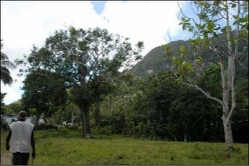Forestry Department courts private sector
Published: Wednesday | April 22, 2009

Marilyn Headley, conservator of forests, and head of the Forestry Department. - Rudolph Brown/Chief Photographer
The Forestry Department, now preparing for transition to a performance-based institution in the form of an executive agency, plans to earn a portion of its keep by increasing production of wood in partnership with landowners.
"The private sector has more land suitable for commercial forestry, and a greater capacity for realising economic benefits from forests, than does the government," said the state-run agency.
"Partnerships to increase the participation of private landowners and investors in development of the forestry sector are therefore essential."
That statement was contained within its Strategic Management Plan 2009-2013.
Jamaica's national forest cover was estimated at 333,000 hectares in 2008, covering 30 per cent of Jamaica.
It is not a precise count, but was estimated using baseline data from the turn of the decade, which assumed a deforestation rate of 0.1 per cent per year.
Forestry has only a vague sense of the economic value of the nation's tree population.
The last estimate was in the 1990s when FIDCO, another state agency, estimated that Jamaica's Caribbean pines were worth $40 million, according to Owen Evelyn, senior director of forest science and technology.
Evelyn also told Wednesday Business that the National Aeronautics and Space Administration of the United States, or NASA, has agreed to provide, for free, a more accurate count of its forestry cover by March 2010.
Potential income sources from forestry include hardwood produced for export and local use.
Only 20 per cent of hardwood needs are met locally. The potential in this area is indicated by the example of Papua New Guinea, the third largest exporter of tropical hardwood, which has an annual trade valued at more than US$220 million.
Jamaica remains dependent on imports to meet the majority of the demand for sawn wood and wood-based panels.
The Forestry Department is being transformed into a Type B executive agency, said communications manager, Stephanie Donaldson Francis.
A 'B' agency is partially funded by government.
"Our major source of supplementary income will be from the forest plantations which were first established by FIDCO and which are still under our management," said Evelyn.
Main species of trees targeted for commercial exploitation include Caribbean pine as well as hardwoods like mahogany, mahoe and cedar.
Added income
"The only problem is that we do not have the mills and treatment plants," said the senior director.
"We have been talking to the private sector about establishing these."
And, for added income, the department will also be offering products like digital maps, and promote its recreational park in Clarendon, known as 'Guri'.
Part of the department's transformation includes identifying the right personnel.
"We are restructuring the agency," said Donaldson Francis.
The department needs "many" foresters of different grades, and personnel with skills in wood industry, maps, geographic information systems (GIS), licensing, lumber harvesting and replanting, biology, education, nursery management, private and community forestry, legal affairs and enforcement, research, sociology and urban forestry.
Forestry has the lead responsibility for the management and conservation of Jamaica's forests.
Much of the existing forest cover, land requiring restoration of forest cover to maintain environmental integrity, and land suitable for commercial forestry or agroforestry is privately owned or otherwise outside the direct control of the Forestry Department.
Conservation of these areas plus the realisation of economic benefits from forest products can be achieved only by substantially increased involvement of the private sector and NGOs.
In addition to hardwood, other sources of earnings include medicinal and aromatic plants for essential oils.
Caribbean neighbour, Grenada, is the world's second largest producer of essential oils derived from the seeds of the nutmeg tree.
Potential also lies in coal production for grill cooking. A study carried out two decades ago in 1988 estimated annual charcoal demand at 60,000 tonnes, inclusive of commercial usage.
Projected increase was estimated using an annual population growth rate of 1.6 per cent.
Locally, the furniture industry is a major hardwood consumer. It is estimated that there are 760 small furniture establishments islandwide, employing up to five persons each.
Progress
The Forestry Department claims that significant progress has been made in engaging the private sector and non-government sector since approval of the 2001 National Forest Management and Conservation Plan (NFMCP), which highlighted the importance of partnerships.
Over the next five years, increased participation of landowners in generating and maintaining forest benefits will be encouraged by improved incentives for maintaining existing forest and for establishing or restoring tree cover.
About 88,000 hectares was closed broadleaf forest. The NFMCP has also identified 69,244 hectares suitable for forestation or reforestation, most of which are private lands.
Only 2,190 hectares are reserves.
Reducing deforestation and restoring forests are high national priorities, according to the department's five-year strategic report.
avia.ustanny@gleanerjm.com

A local walks by trees at the foot of the heavily forested Dolphin Head Mountains in Hanover, a protected area that foresters have been trying for years to safeguard from plunder by charcoal burners, and other illicit acitivity. - File















